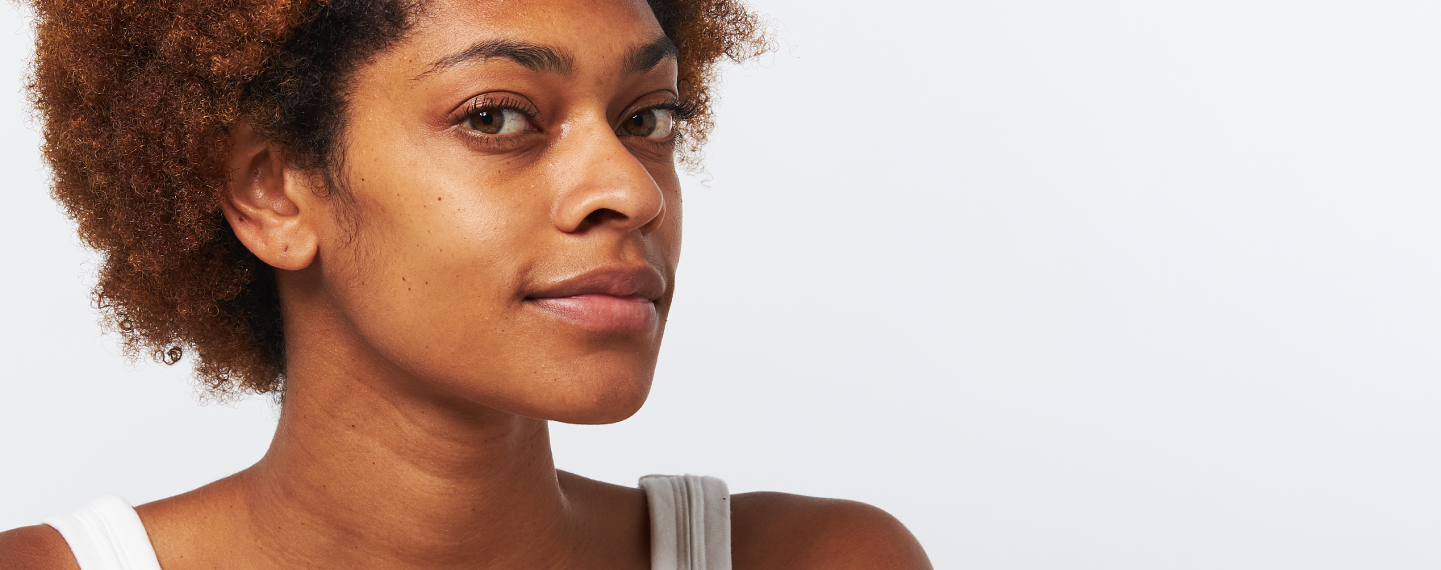Education
Your Guide to Skin Tightening Treatments


SHARE
Education
Your Guide to Skin Tightening Treatments
Medically reviewed by Katelyn Hagerty FNP
Written by Apostrophe Team
Last updated 4/5/2024
Noticing the effects of aging on your skin is a fairly normal part of getting older.
The skin on your neck may have a looser appearance than it did in your younger years, or you may notice that your eyelids have begun to crinkle similar to crepe paper.
Skin tightening treatments are some of the more popular ways you can help return your skin to the way it looked when you were younger.
Read on for our complete guide to all things skin tightening treatments — which treatments are available to you, how much they may cost, and other tips on how you can care for your skin now to help it maintain its youthful appearance in the coming years.
What Are Skin Tightening Treatments?
Skin tightening treatments are non-surgical cosmetic procedures that stimulate collagen and elastin production in your skin in order to make it appear fuller and reduce the appearance of fine lines, sagging, wrinkles, and loose skin.
Some treatments also reduce the appearance of cellulite by affecting the fibrous tissue in your skin, resulting in smoother skin.
You have three layers of skin, the epidermis, or outermost layer of skin, the dermis, the middle layer of skin, and the hypodermis, your deepest layer.
Skin tightening treatments work on the dermis layer of your skin, where collagen and elastin are produced, using heat to stimulate the production of the two proteins and help firm up your skin.
Because skin tightening treatments need to work on the dermis layer of skin in order to be effective, topical treatments that claim to be skin tightening face products will not be effective for the tightening of skin because they’re not able to penetrate deeply enough.
If you prefer to go the topical treatment route, there are products that are effective for treating the effects of aging. We’ll touch on those once we’ve covered the different skin tightening treatments.
What Can You Expect from Skin Tightening Treatments?
As your body ages, the production of collagen and elastin in our skin slows.
Non-surgical procedures serve to temporarily stall the resulting formation of lax skin by tightening skin on the face, neck, and body to reduce the effects of aging.
Depending on the procedure, you can expect to see tighter skin within weeks to months of treatment.
Since the goal is to stimulate elastin and collagen production, the changes happen over time.
Some procedures will need to be performed repeatedly in order to see results, and all will need to be repeated from time to time in order to give those results staying power.
These treatments can be performed in a dermatology professional’s office, and most can be wrapped up within an hour.
It is important to note that the effects of skin tightening treatments are noticeable — but subtle.
They won’t be effective on skin that sags heavily from, say, a large amount of weight loss, or the results of aging that have gone untreated for years.
In such cases, you’ll need to look into more invasive procedures.
What Are the Types of Non-Invasive Skin Tightening Treatments?
The purpose of a non-invasive treatment is to promote the production of collagen in your skin without leaving you with any wounds or other openings in the skin.
You may notice some swelling or redness after the procedure, but in most cases, it’s just temporary and the only physical indication that you’ve been treated.
Your skin type won’t make a difference here, as these treatments are safe for all skin colors. As with any skin procedure, you’ll want to make sure that you’re being treated by a board-certified dermatologist to ensure a safe process.
Procedures in this category have no side effects other than the aforementioned swelling and redness, so you’ll be free to return to normal activities after your treatment.
However, you may experience mild discomfort while the procedure is being performed.
Radiofrequency (Non-invasive)
In this procedure, a handheld device is placed against your skin to emit radiofrequency energy and heat the tissue underneath.
The majority of people get one round of this treatment done, and see their best results around six months out.
Results can last two to three years.
Laser Treatment
During this procedure, a laser is used to send heat into your skin. While it can be used anywhere on the body, it is particularly effective for tightening skin on the belly and upper arms.
This is usually done over three to five treatment sessions, and results appear two to six months after the final session has been completed.
Ultrasound
With ultrasound skin tightening treatments, ultrasound energy is transmitted through the skin to heat up the dermis layer to stimulate collagen and elastin production.
Ultherapy® is the most popular name brand of this procedure and is FDA-approved for the treatment of the skin on the neck, chin, chest, and brow.
What Are the Types of Minimally-Invasive Skin Tightening Treatments?
With minimally invasive skin tightening procedures, you’ll still be able to get results without surgery, but you’ll have to plan for some downtime after your treatment. Sedation is required for this type of procedure.
Radiofrequency (Minimally-invasive)
This skin tightening procedure goes a bit deeper than the radiofrequency mentioned above.
It involves the insertion of a thin tube or needles under the skin to target exactly the area that needs tightening.
It is often used to target lax or sagging skin on the neck or upper arms.
The precise targeting of this type of radiofrequency allows results to show faster, usually within one month of treatment, and results can continue to improve for up to one year.
After treatment, you’ll need to perform wound care and may need to wear a compression garment for four to five days.
Be sure you have a friend to escort you home from your appointment.
Laser Resurfacing
This is the most invasive of the non-surgical skin tightening treatments, so you’ll need to plan to stay home for up to a week after treatment.
It is a more powerful treatment than the one mentioned above, but you’ll also see quicker results starting around two weeks after you heal.
It’s best to get this sort of treatment in the fall or winter when you’re exposing your skin to less sun, as laser-treated skin is particularly sensitive to sun exposure.
It is important to seek out a provider with particular expertise in laser treatments, as the treatment can be ineffective or even damaging when performed by someone with limited experience.
What Do Skin Tightening Treatments Typically Cost?
Skin tightening treatment costs vary widely, depending on your location, who your dermatology provider is, your insurance, and the type of treatment you’re getting.
If you’re considering getting a skin tightening treatment, it’s best to start with providers who are skilled in the type of treatment you’re looking to receive, and then figure out costs from there.
While you’ll find variance in costs between providers, the cheapest isn’t always the best choice.
Your dermatology provider can help guide you in seeking skin tightening treatment, and you can check out the American Board of Cosmetic Surgery’s price estimator, as well.
What Are Some Alternatives to Skin Tightening Treatments?
If you’re aiming to reduce or delay the effects of aging and would like to go in a direction other than a procedure at a dermatologist’s office, topical products are also an option.
The Apostrophe Anti-Aging Topical Cream can be formulated with the active ingredient tretinoin to stimulate collagen production in your skin and slow down the effects of aging.
Antioxidants, like vitamin C, remove free radicals from your skin, helping protect it from your environment as you go about your day to day.
Final Thoughts on Skin Tightening Treatments
For mild to moderate skin sagging, skin tightening procedures might be just what you need to give your skin a boost in how it looks and feels.
You’ll need a board-certified dermatologist to provide these procedures for you, but your dermatology provider can guide you in sorting through your treatment options.
To prevent the effects of aging before they get too far, be sure to incorporate anti-aging products into your skincare regimen for happy, healthy skin as you get older.
As with any skin condition, prevention is just as important as treatment. So, even if you’ve already started to notice the effects of aging on your skin, it is never too late to start on a prevention plan.
6 Sources
Non-surgical skin tightening. American Board of Cosmetic Surgery. Retrieved from https://www.americanboardcosmeticsurgery.org/procedure-learning-center/non-surgical-procedures/skin-tightening/
Skin. (2021, October 13). Cleveland Clinic. Retrieved from https://my.clevelandclinic.org/health/articles/10978-skin
Many ways to firm sagging skin. American Academy of Dermatology Association. Retrieved from https://www.aad.org/public/cosmetic/younger-looking/firm-sagging-skin
Laser skin resurfacing: Top 8 things you need to know. (2021, March 17). American Board of Cosmetic Surgery. Retrieved from https://www.americanboardcosmeticsurgery.org/skin-resurfacing/the-top-8-things-you-need-to-know-about-laser-skin-resurfacing/
Sumita, J. M., Leonardi, G. R., & Bagatin, E. (2017). Tretinoin peel: a critical view. Anais brasileiros de dermatologia, 92(3), 363–366. Retrieved from https://www.ncbi.nlm.nih.gov/pmc/articles/PMC5514577/
Addor F. (2017). Antioxidants in dermatology. Anais brasileiros de dermatologia, 92(3), 356–362. Retrieved from https://www.ncbi.nlm.nih.gov/pmc/articles/PMC5514576/
Like what you just read? Sign up for our email list to get the scoop on skincare science delivered straight to your inbox.

Deep Dives
A dermatologist shares his thoughts on the recent studies about benzoyl peroxide and benzene.
Read More
Education
What is milia?
What is milia? Today, we’re jumping into one type of bump that you may have heard about most commonly in infants — milia.
Read More
Education
Best moisturizer for acne-prone skin
If you have combination acne-prone skin, figuring out which moisturizer is best for your skin might be tough. In this guide, we break down the best moisturizer for combination, acne-prone skin.
Read More
